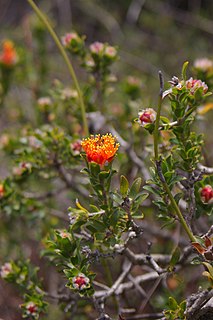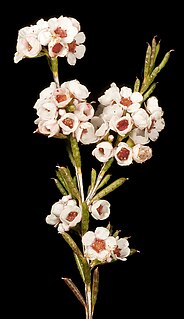
Beaufortia is a genus of woody shrubs and small trees in the family Myrtaceae and is endemic to the south-west of Western Australia. The genus Beaufortia is closely related to Melaleuca, Calothamnus, Regelia and several others, differing mainly in the way the anthers are attached to the stalks of the stamens, and in the way they open to release their pollen. Beaufortia anthers are attached at one end and open by splitting at the other.

Kunzea salina is a species of flowering plant in the myrtle family, Myrtaceae and is endemic to the south of Western Australia. It is a low, spreading, densely branched shrub with leaves mostly arranged in opposite pairs and usually two sessile pale pink to white flowers arranged at the base of new shoots. It only grows near the edge of certain salt lakes.

Astartea is a genus of flowering plants in the myrtle family, Myrtaceae. The genus is endemic to southwestern Western Australia. The genus name was inspired by Astarte, the Greek name for the goddess Ishtar.

Thryptomene is a genus of small shrubs in the family Myrtaceae described as a genus in 1838. The entire genus is endemic to Australia.

Eremaea is a genus of woody shrubs and small trees in the family Myrtaceae and is endemic to the south-west of Western Australia. Little study of the genus as a whole had been undertaken until Roger Hnatiuk researched Eremaea and published a paper in 1993, A revision of the genus Eremaea (Myrtaceae) in Nuytsia. The first species to be described was Eremaea pauciflora in 1837 and by 1964, the number of species known had increased to 12. Hnatiuk recognised 16 species, 5 subspecies and a number of varieties.
Seorsus is a genus of flowering plants in the family Myrtaceae. The occurrence of the four species in Australia and Borneo is widely spaced, and is thought to be indicative that the genus predates the breakup of Gondwana.

Astartea fascicularis is a species of flowering plant in the myrtle family, Myrtaceae. It is endemic to southwestern Western Australia, where it is widespread in the Recherche Archipelago and present on the mainland in Cape Le Grand National Park. It is commonly known as Recherche astartea. or false baeckea.

Aluta is a genus of small shrubs in the family Myrtaceae. Species occur in Western Australia, South Australia and the Northern Territory. When the genus was erected in 2000, three species were transferred from the genus Thryptomene.

Rinzia is a genus of flowering plants in the family Myrtaceae. The genus was first formally described in 1843 and reinstated and revised in 1986. The entire genus is endemic to Western Australia.

Dicrastylis is a genus of plants in the Lamiaceae, first described in 1855. The entire genus is endemic to Australia. The type species is Dicrastylis fulva.

Malleostemon is a genus of flowering plants in the myrtle family Myrtaceae, described as a genus in 1983, by John Green The entire genus is endemic to Western Australia.
- Malleostemon costatusRye & Trudgen
- Malleostemon decipiens(W.Fitzg.) Trudgen
- Malleostemon hursthousei(W.Fitzg.) J.W.Green
- Malleostemon microphyllusRye & Trudgen
- Malleostemon minilyaensisJ.W.Green
- Malleostemon nephroideusRye
- Malleostemon nerrenensisRye & Trudgen
- Malleostemon pedunculatusJ.W.Green
- Malleostemon peltiger(S.Moore) J.W.Green
- Malleostemon pustulatusRye
- Malleostemon roseus(E.Pritz.) J.W.Green
- Malleostemon tuberculatus(E.Pritz.) J.W.Green
- Malleostemon uniflorusRye
Ochrosperma is a group of shrubs and small trees in the myrtle family Myrtaceae described as a genus in 1987. The genus is endemic to Australia.
- Ochrosperma adpressumA.R.Bean - Queensland
- Ochrosperma citriodorum(Penfold & J.L.Willis) Trudgen - New South Wales
- Ochrosperma lineare(C.T.White) Trudgen - Queensland, New South Wales
- Ochrosperma obovatumA.R.Bean - Queensland
- Ochrosperma oligomerum(Radlk.) A.R.Bean - New South Wales
- Ochrosperma sulcatumA.R.Bean - Northern Territory
Micromyrtus trudgenii is a plant species of the family Myrtaceae endemic to Western Australia.
Rinzia carnosa, commonly known as the fleshy leaved rinzia, is a plant species of the family Myrtaceae endemic to Western Australia.
Rinzia schollerifolia, commonly known as the Cranberry rinzia, is a plant species of the family Myrtaceae endemic to Western Australia.
Barbara Lynette Rye is an Australian botanist born in 1952.
Enekbatus is a genus of shrubs in the family Myrtaceae described as a genus in 2010. Enekbatus are endemic to Western Australia.
Enekbatus clavifolius is a shrub endemic to Western Australia.
Enekbatus stowardii is a shrub endemic to Western Australia.
Malcolm Eric Trudgen is a West Australian botanist. He has published some 105 botanical names. He currently runs his own consulting company, ME Trudgen and Associates.








